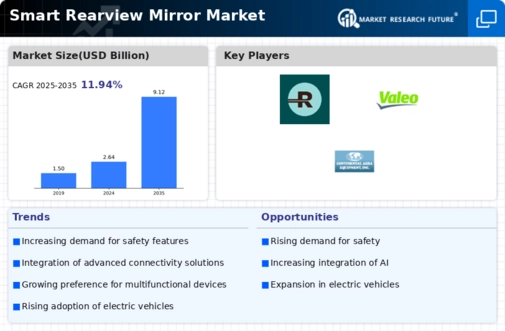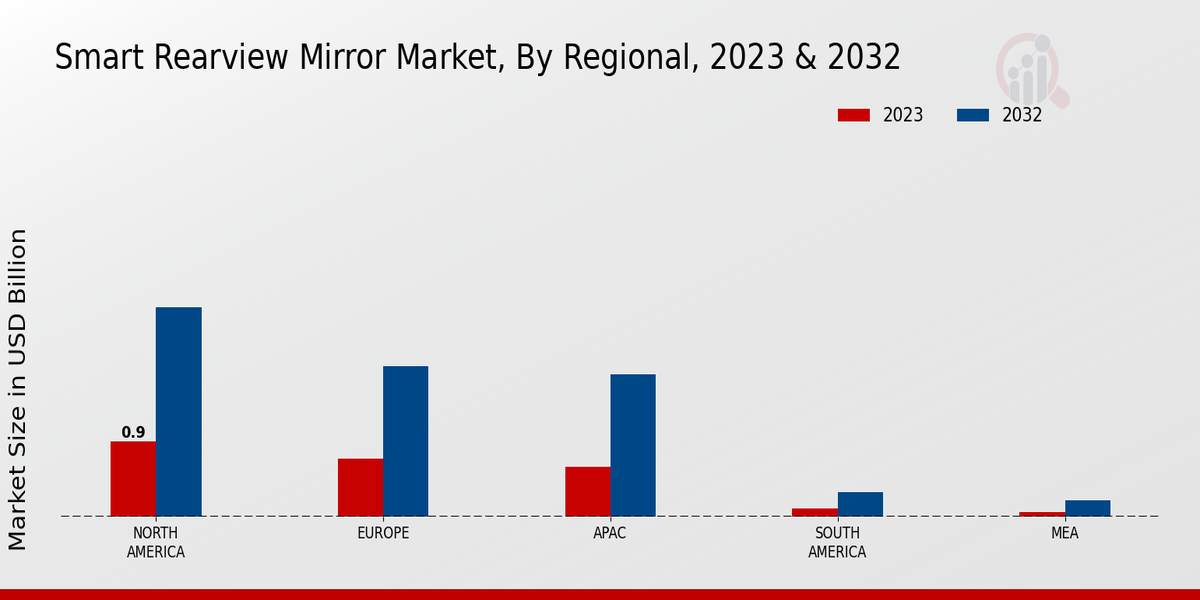Market Growth Projections
The Global Smart Rearview Mirror Market Industry is projected to experience substantial growth over the next decade. With a market valuation of 2.64 USD Billion in 2024, it is anticipated to reach 9.12 USD Billion by 2035, reflecting a robust compound annual growth rate of 11.94% from 2025 to 2035. This growth trajectory is driven by various factors, including technological advancements, rising safety demands, and increasing electric vehicle adoption. As the industry evolves, the integration of smart technologies in vehicles will likely become a standard feature, further propelling market expansion.
Technological Advancements
The Global Smart Rearview Mirror Market Industry is experiencing rapid technological advancements, particularly in the integration of augmented reality and artificial intelligence. These innovations enhance driver safety and convenience by providing real-time information, such as navigation and traffic updates, directly within the driver's line of sight. As a result, consumers are increasingly drawn to vehicles equipped with smart rearview mirrors, which are projected to contribute to the market's growth. In 2024, the market is valued at 2.64 USD Billion, and as these technologies continue to evolve, they are expected to play a pivotal role in driving demand.
Government Regulations and Initiatives
The Global Smart Rearview Mirror Market Industry is shaped by various government regulations and initiatives aimed at improving road safety. Many countries are implementing stricter safety standards for vehicles, which often include the incorporation of advanced driver-assistance systems (ADAS). Smart rearview mirrors, as part of these systems, are becoming essential components in meeting regulatory requirements. Governments are also promoting the adoption of smart technologies through incentives and subsidies, further encouraging manufacturers to innovate. This regulatory landscape is expected to foster market growth, as compliance with safety standards becomes increasingly critical for automotive manufacturers.
Increasing Adoption of Electric Vehicles
The Global Smart Rearview Mirror Market Industry is likely to benefit from the increasing adoption of electric vehicles (EVs). As the automotive industry shifts towards sustainability, EV manufacturers are incorporating advanced technologies, including smart rearview mirrors, to enhance user experience and safety. These mirrors not only provide essential driving information but also contribute to the overall aesthetic and functionality of modern EVs. The integration of smart mirrors in EVs aligns with consumer preferences for innovative and eco-friendly solutions, thereby driving market growth. This trend is expected to sustain the market's compound annual growth rate of 11.94% from 2025 to 2035.
Rising Demand for Vehicle Safety Features
The Global Smart Rearview Mirror Market Industry is significantly influenced by the rising demand for enhanced vehicle safety features. Consumers are becoming more aware of the importance of safety technologies, leading to a growing preference for vehicles equipped with smart rearview mirrors. These mirrors often include features such as blind-spot detection and collision warnings, which are crucial for accident prevention. As safety regulations become stricter globally, manufacturers are compelled to innovate and integrate these features into their vehicles. This trend is expected to propel the market, with projections indicating a growth to 9.12 USD Billion by 2035.
Consumer Preference for Connectivity Features
The Global Smart Rearview Mirror Market Industry is witnessing a shift in consumer preferences towards connectivity features in vehicles. Modern drivers are increasingly seeking integrated solutions that offer seamless connectivity with smartphones and other devices. Smart rearview mirrors that provide features such as hands-free calling, navigation, and media streaming are becoming more appealing. This trend reflects a broader movement towards smart technology in everyday life, where consumers prioritize convenience and connectivity. As manufacturers respond to these preferences by enhancing the functionality of smart rearview mirrors, the market is poised for substantial growth in the coming years.














